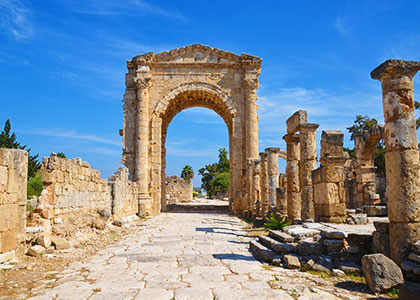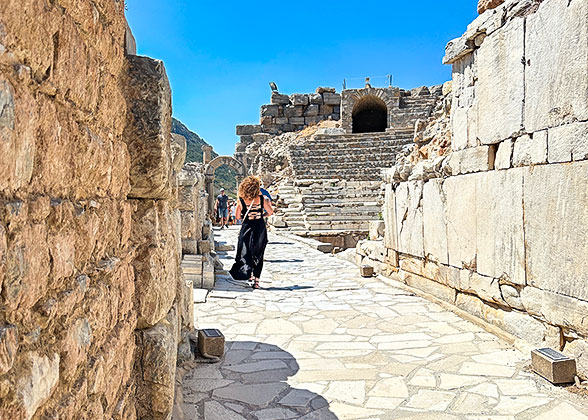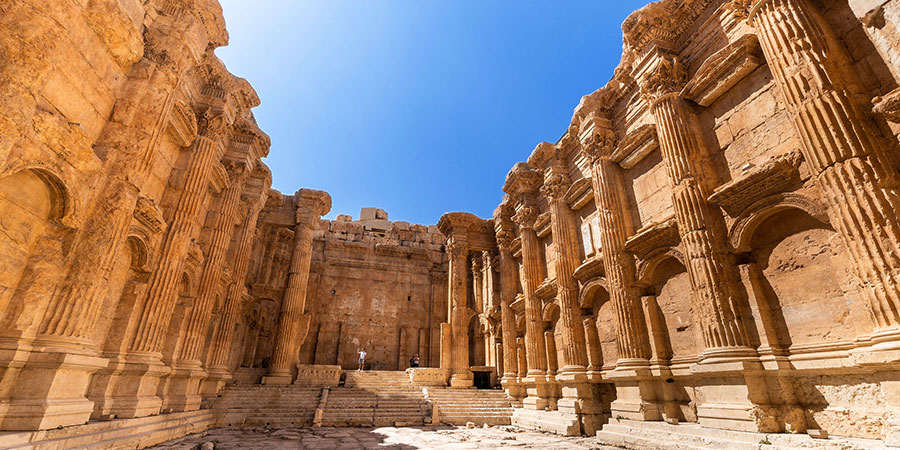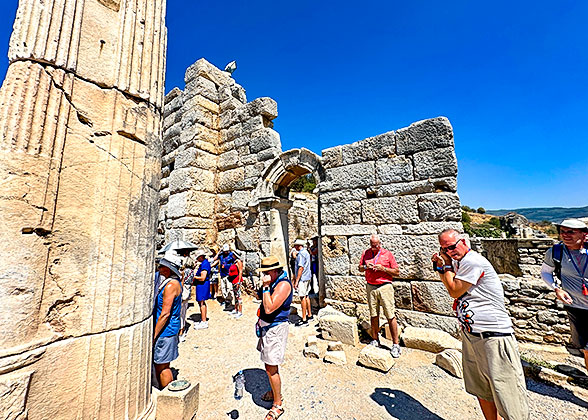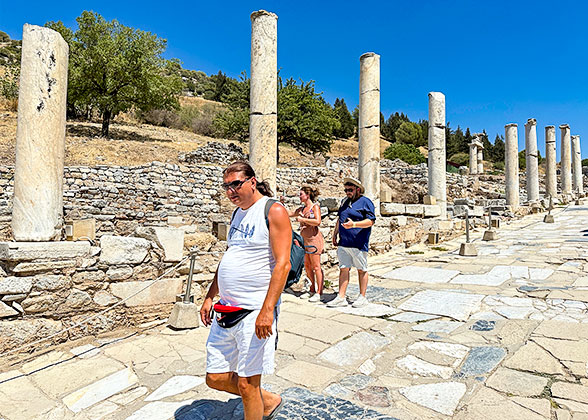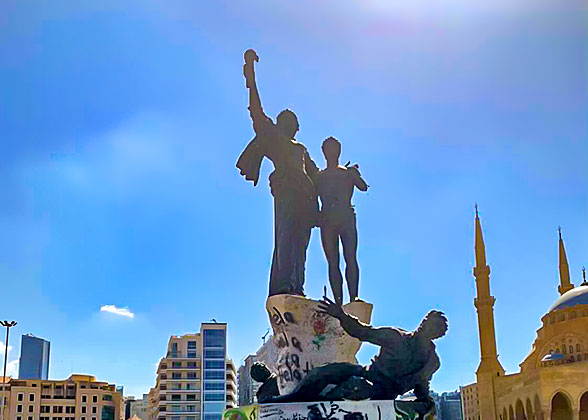Day 1: Arrival in Beirut; Airport Pick-up
Welcome to join our panoramic line of best Lebanon tours! We have arranged an experienced driver to meet you on time in Beirut Rafic Hariri International Airport. After a warm welcome, the driver will transfer you to the hotel in a comfortable private car exclusive for you. Activities & Dinner Suggestion:Considering that you may need a good rest after your long flight, we have no plans for today. You can spend the rest of the day as you please. Take a break in the hotel or get out for a quick look of the capital Beirut. The 5 stars Radisson Blu Hotel we selected for you has a restaurant on the ground floor and a shopping mall nearby. We also provide you with a 4 stars option, Gems Hotel, located on the busy Hamra Street, where you can shop, have a cup of coffee or, if you prefer, stop at a small bar in the evening to experience and immerse yourself into the Lebanese life. ► Food Recommendations: Lebanese eat flat pita bread with everything. You can expect and try the Lebanese cuisine, which won’t let you down. Kibbeh (deep-fried croquettes with minced beef), tabbouleh (Arabic parsley salad), hummus (seasoned chickpea paste), Falafel (spiced balls of chickpeas), and more can be wrapped in the flatbread. Manakish, also called Lebanese pizza, challenges your taste bud as well with rich toppings on the flatbread.
|
Day 2: Highlights of Capital Beirut
Our guide and the driver will pick you up from your hotel. The first stop today is the National Museum of Beirut. It would be an eye-opening experience to see the Phoenician Alphabet Tablet, ancient Roman sculptures, stone coffins with fine reliefs, and many other relics of the Iron Age. Next, the guide will lead you to visit the Mohammad Al-Amin Mosque and the nearby St. Georges Maronite Cathedral.
★ Phoenician Alphabets – The World's First Alphabet System
Do you know how the earliest alphabets were written? In the National Museum of Beirut, the sarcophagus with Phoenician alphabet will show you the answer. The stone coffin of King Ahiram, the biggest treasure of the museum, has preserved an inscription of the old alphabets. It is dated back to the 11th century BC, telling of a curse that the king’s son uttered to invaders after he made the sarcophagus for his father. Phoenician alphabet is the first phonetic letter system in the world, and is considered likely to be the ancestor of Greek alphabet and even all western alphabets. Invented by the Phoenicians, forebear in Lebanon, Phoenician alphabet had been spread over the Mediterranean area through thriving trades long before.
After lunch, we'll have a relaxed walk around the Beirut Souks to see the landmark Clock Tower. Later, a special stop is arranged for you to the American University of Beirut, where you can know the real charm of this campus nicknamed “Harvard of the Middle East”. The Archaeological Museum on campus is worth a visit.
► Interesting Confusion about Lebanon Time
When seeing that the clocks in Beirut show different times, you may be wandering what’s going on here. It’s because of the alternation of seasonal time, and multiple parties as well as religions. One party announces the winter or summer time changes as many countries do, but another party may claim a different date to carry out the alternation. Thus, you’d better confirm the appointed time with our guide in details if confused, especially during the alternation months of March to April and October to November.
Before nightfall, we'll approach the Mediterranean seaside. Complete the day by taking photos and watching the sunset with the guide as you stroll along the beautiful seafront Corniche lined with palm trees, and see the offshore natural wonders of the Pigeon Rocks (Raouche Rocks).
Meals: Breakfast, Lunch
|
Day 3: Northern Trip to Jeita Grotto, Harissa & Byblos
This morning, we'll start our tour with a half-hour car ride to the Jeita Grotto, a group of prehistoric karstic caves located in the Nahr al-Kalb Valley of Jeita Town, 18 km (11 mi) northeast of Beirut. The guide will lead you to take the cable car to reach the upper cave for a visit, and we will specially arrange an exciting boat tour for you to travel along the underground river. Next, we will drive 20 minutes along the mountain road to Harissa. Our staff have considerately booked the gondola lift for you, from where you could get a bird's-eye view of the Jounieh Bay and the iconic pilgrimage site - the Shrine of Our Lady. Afterwards, we'll proceed further north to Byblos, in 20 minutes by car. It is one of the oldest continuously inhabited cities and a World Heritage site of Lebanon. We'll see the old castle, the Church of St. John, the Roman amphitheater and the old souks, which will all impress you. Finally, our guide and the driver will escort you to the hotel in Byblos. ★ Byblos – Origin of the Word “Bible”Byblos was a well-known trading port around the Mediterranean area in ancient ages, and papyrus was a vitally important trade goods by sea. Papyrus, from Egypt, was transported to ancient Greece and Rome via Byblos around the 8th century BC. It’s said that Herodotus, ancient Greek historian and writer, named papyrus as “Byblos”, the name of the city. Since then, Byblos became the synonym of papyrus; Bible, meaning for papyrus book originally, was also believed to be evolved from “Byblos”. Yes, Bible, the sacred scripture as you know. Meals: Breakfast, Lunch ► Note: This is the only one night of our trip spent outside Beirut. We have handpicked two hotels in Byblos to suit your different needs and budgets. The 4 stars Aleph Boutique Hotel is close to the ancient city and a 10-minute walk from the nearest beach. Another option is the 5 stars Byblos Sur Mer Hotel, which occupies a privileged location overlooking the Bahsa Beach on the Mediterranean Sea. You can relax in its outdoor pool and spend a pleasant evening in its cozy cafe on a terrace.
|
Day 4: Adventure to Kadisha Valley (Holy Valley) & Forest of the Cedars of God
Our guide and the driver will wait for you in the hotel lobby after breakfast. It takes 1.5 hours on the way to Becharre (Bsharri). We will stop at Tannourine Town midway to appreciate the three natural bridges. After arrival in Becharre, the guide will first lead you to visit the museum in memory of the famous Lebanese-American poet Kahlil Gibran (1883 - 1931). We'll stroll through the peaceful Forest of the Cedars of God (Horsh Arz el-Rab), where the cedars have been growing for 1,500 years. ► Cedars, the Tree on the National Flag of Lebanon
What’s the pattern in middle of the national flag of Lebanon? It is a cedar. How weird to print a tree on the national flag! Lebanon honors cedars as the national tree, which had played a crucial role in the country. It was important in trades of ancient Phoenicians, as they exported cedar wood to Egypt and more countries around the Mediterranean Sea, to construct palaces, temples for Gods, ships and boats. Temple of Solomon was just built with Lebanese cedars, and the famous Solar Boat of Egyptian Pharaoh Khufu took cedars as a building material in its construction. As both goods and great material for building merchant ships, cedars helped Phoenicians create a powerful trading empire of maritime transportation.
★ Unique Experience: Kadisha Valley Hike with Expert Guide
The highlight of today would be the Kadisha Valley, aka Holy Valley, or Ouadi Qadisha, which was inscribed as an UNESCO World Heritage site in 1998. Our expert guide, who visits the mountains at least 30 times a year, is very familiar with the hiking trails. Follow the guide's steps to walk along the Kadisha River, the steep slopes, unspoiled springs, waterfalls, as well as chapels and monasteries will come into view. On the way, the guide will lead you to visit the Qozhaya Monastery dating back to the 12th century. Finally, we’ll return to Beirut tonight.
Meals: Breakfast, Lunch
Roman Ruins in Lebanon Umayyad Ruins, Anjar
|
Day 5: World heritage Tour to Anjar & Baalbek
Today begins with a 1.5-hour car ride to Anjar, an ancient city built in the 8th century and included in the World Heritage List in 1984. Our guide will take you to visit the grand Umayyad Ruins, through which you can imagine the past glory of Anjar, which was once home to luxury palaces, public baths, mosques, and a remarkable central street lined with more than 600 shops. ► The Only Witness of Umayyad Urban Construction in LebanonAnjar is unique in Lebanon as only Umayyad culture settled here, while other world heritage sites see several civilizations. In the early 8th century, Walid Ⅰ, the caliph of Umayyad Empire, designed the city of Anjar in person. It was a square city, not large-scaled but systematic on the whole. Palaces, public baths and mosques can be found in the ancient city, and the public baths in the north were distinctly impacted by Roman style. In the middle of most fertile land, Anjar owns a few underground springs, which couldn’t be better in the inland area. One spring was the liveliest place in Anjar once, where hundreds of people gathered for picnics or dinner in restaurants that served fresh freshwater fishes. Later, we will continue our journey to Baalbek Temple Complex, which is the biggest Roman ruins in the world and another World Heritage site of Lebanon. The guide will show you three must-sees here – the Temple of Jupiter, the Temple of Bacchus, and the Temple of Venus. Before returning to Beirut, we'll offer you a special visit to the renowned Chateau Ksara to taste some of the best local wines. If you are not interested in wine, we can arrange a visit to the Taanayel Lake for you as an alternative. Meals: Breakfast, Lunch Ruins of Baalbek Umayyad Ruins, Anjar
|
Day 6: Hike Shouf Cedars Reserve & Visit Deir Al-Qamar
After breakfast, we'll head for the largest nature reserve in Lebanon, Shouf Cedars Reserve, in one hour by private car. Get up close with the cedar trees that have been growing for more than 2,000 years as you hike through the reserve with our experienced guide. Next, we'll drive half an hour to the Beiteddine Palace, a 19th-century palace once used to be the government building of the Ottoman Empire. Now, half of the palace is open to tourists and the other half is served as the summer palace for Lebanon's president.
► Beautiful Palace? Brutal Fact behind the Scenes
No one can deny that Beiteddine Palace is perfectly magnificent, with splendid architecture, wonderful garden, historic mosaics, and distinctive Arabic decorations. However, it’s said that the hands of its designers and artisans were cut off after the palace was completed. It was first built as the palace and home of emir Bashir Shihab Ⅱ at the end of 18th century. Bashir Shihab Ⅱ gathered a large number of architects and artisans, to construct the extravagant palace as he had hoped. In order to own the palace alone and avoid any copy, he ordered to cut off hands of these artisans. What a horrible secret of the fantastic palace, or most of the marvelous palaces in the world!
Our last stop today is Deir Al-Qamar, a small village known for long history and picturesque scenery. Wander along the quiet pebble streets lined with stone houses with delicate gardens, and you'll find inner peace. In the evening, the guide will escort you back to the hotel in Beirut.
Meals: Breakfast, Lunch
|
Day 7: Southern Lebanon Ports – Tyre & Sidon
In the morning, the guide will accompany you in our private car running to Tyre in 1.5 hours. Tyre, an ancient Phoenician city along the west coast of Lebanon, was the birthplace of the dye of Tyrian purple which was considered the classiest color by ancient Roman and Egyptian royals. Our knowledgeable guide will show you around the ruins of Tyre while telling you the interesting stories of this World Heritage site. We'll see the Egyptian Port, ancient public baths, Roman necropolis and hippodrome. ► Imagine a Venturous Chariot Racing at Roman HippodromeFollowing our guide, you will see Roman Hippodrome in Tyre ancient city. Even though it has been partly in ruins, you can be wandering that the galloping chariots crossed the course before you as well as cheering crowds on spectator seats. Chariot racing was wildly popular in ancient Roman Empire. A chariot was dragged by four horses generally, and charioteers drove their chariots to circle around the field at top speed, turning round at the column at the end. They would circle for 7 or 9 times in a racing, dangerous, furious, and death-defying with high return. You could imagine an accident occurred as the charioteer thrown off by runaway horses was trampled by the chariots from behind, and also the winner brought down the house and gained glory and money. On the way back to Beirut, we'll visit Sidon, another ancient coastal city built by the Phoenicians. Follow our well-designed route so that you won't miss any of Sidon's best attractions, including the Crusaders' Sea Castle, the old souks, Debbaneh Palace, Saint Nicholas Cathedral, and the Temple of Eshmun. The guide will show you around all these places and explain them in detail. Meals: Breakfast, Lunch
|
Day 8: Leave Beirut; Airport See-off
Our service draws to an end today. Our driver will meet you at the hotel lobby at the agreed time and then transfer you to the Beirut Rafic Hariri International Airport for your flight home or to your next destination. Wish you a pleasant trip! Meals: Breakfast ► Please contact our travel consultants anytime when you need help in planning extension trips to Egypt, Jordan, Israel or other nearby destinations.
|

